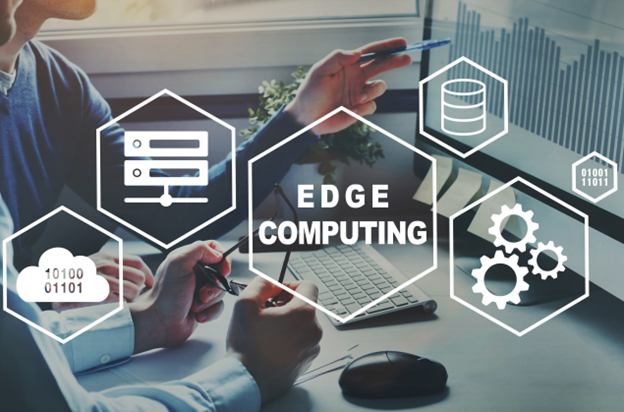A Simple and Clear Understanding of Edge Computing
Imagine a world where data is processed rapidly, decisions are informed in near-real-time, and your business or public service operates with exceptional efficiency. This isn’t in the distant future; it is a reality right now brought to life by Edge Computing.
At its core, edge computing is about processing data near its source rather than transmitting it to distant data centers. It’s like moving the brains of your operation closer to its hands and feet.
This proximity speeds up reaction times and enhances operational efficiency, transforming small to midsize businesses and local government functions.
Edge computing promises to unlock…
- Unprecedented efficiencies
- Bolster’s data security
- Helps organization with scalable growth
In this quick guide, we aim to explain the concept of edge computing and its potential for small to mid-sized organizations.
We’ll delve into its comparison with cloud computing and its role in shaping the digital future. We’ll present the roadmap to implement edge computing and look at the future.
What is Edge Computing?

It is a technique where data processing happens near where it’s actually needed instead of being done far away.
Instead of sending data over a long trip to a faraway data center, it’s processed nearby or “at the edge.”
This makes everything work faster and more efficiently, which is a big help for businesses of all sizes.
Over the years, it has evolved from a lesser-known technology to a mainstream solution. Many people initially had doubts, similar to early skepticism around cloud computing.
However, its adoption soared once its potential was understood, shaping a new digital paradigm.
In Simple Terms, how can it help your organization?
1. Speed things up:
Just as you don’t want to wait long for a webpage to load, companies also want their applications and systems to respond quickly. Also, data doesn’t have to travel a long way, so responses are quicker.
2. Save on data costs:
Imagine paying for each mile you send a letter; you’d want to keep it close, right? So less data is sent over long distances, which can save a lot of money.
3. Keep things running when your internet connection is down:
Sometimes, the internet can have a hiccup, but a store still needs its cash registers working. It allows important systems to keep running even when the internet is slow or down.
4. Better privacy and security:
Let’s say a company has some important secrets. Keeping those secrets at home is safer than sending them far away. In edge computing, sensitive data can be processed locally, reducing the risk of being stolen.
5. Make customer experiences better:
Imagine if your favorite online game had no lag or your video call didn’t freeze. Edge computing can make these experiences better by reducing delays.
Edge Computing vs. Cloud Computing: The Rundown

In the early days, many perceived cloud computing as the digital world’s saving grace, with the promise of limitless data storage and processing.
However, as our reliance on real-time data skyrocketed, it became evident that the distance to these cloud servers could become a hindrance.
Compared to cloud computing, it brings data processing ‘to the edge,‘ much closer to the source of data collection.
This has a clear advantage: it reduces latency, ensuring data is processed faster. It’s like having a team of expert analysts within your office, ready to interpret data on the spot.
The Big Misunderstanding
The journey of edge computing, much like cloud computing in its infancy. But, like cloud computing, it has been marked by misunderstanding and underestimation.
Businesses initially brushed off edge computing, believing it added unnecessary complexity. But as real-time data processing became increasingly critical, these same businesses realized the untapped potential of edge computing.
It wasn’t adding complexity; it was simplifying operations
Today, it has proven its worth, pushing the boundaries of what’s possible for organizations of every size and local governments. It’s brought about a level of responsiveness and security that we hadn’t imagined before, proving that edge computing is not just a fad but a transformative technological shift.
The Impact of Edge Computing
Statistics have shown a notable uptick in efficiency and profitability for small to midsize organizations and local governments embracing edge computing.
According to a study by Juniper Research, smaller organizations using it have seen an average increase in operational efficiency of up to 30%.
It brings processing power to the doorstep of these businesses, making data-driven decision-making faster and more efficient. Imagine reducing the time between data collection, processing, and action from hours to mere moments.
Edge Computing and Local Governments: Practical Applications

Moving onto the public sector, local governments are finding innovative uses for eit, particularly in managing public resources.
Let’s take the example of traffic management. By processing data locally from traffic sensors, cities can adjust traffic light patterns in real time, reducing congestion and improving road safety.
Similarly, real-time processing of surveillance video data in public safety can help identify potential threats or emergencies faster, enabling swift action.
Sensors can monitor bin levels and optimize collection routes for waste management, leading to significant time and cost savings.
The Future of Remote Work
An often-underexplored aspect is the potential of edge computing to enhance remote work—a trend that has become the new norm.
By reducing latency, it can improve the performance of collaboration tools, enhancing productivity and employee satisfaction.
Many small to midsized organizations initially misunderstood the value of cloud computing, thinking it was an overhyped trend. A similar pattern unfolded with edge computing.
However, the proof is in the pudding, so to speak. Today, it is a critical tool in an increasingly real-time data-driven world, empowering businesses and organizations of every size and reshaping local government operations.
Improving Efficiency
Edge computing holds the key to better efficiency. It brings processing closer to data sources, reducing latency dramatically.
This quicker flow of information opens the door for swift decision-making, creating a competitive edge for SMBs and providing local governments with critical real-time insights for public services.
With this technology, it’s not about waiting for data; it’s about acting on it—now.
Bolstering Cybersecurity

With escalating cyber threats, cybersecurity remains at the forefront for small to mid-sized organizations and local governments. The localized data handling inherent to edge computing can significantly improve data security.
In contrast to traditional cloud computing, it processes most data on-premises, you are minimizing the risk of data breaches during transmission.
Scaling with Edge Computing
Growth is the goal of any organization, but it should not compromise cost-effectiveness.
It shines in this aspect, enabling organizations to scale operations without a parallel expense increase. By decreasing the need for bandwidth and central data processing, edge computing allows you to expand without the growing pains.
An Overlooked Benefit: The Environmental Angle
While efficiency, security, and scalability often hog the limelight, there’s an underexplored benefit to it—the environmental aspect.
It minimizes data transmission distances, which, in turn, reduces energy consumption. Choosing edge computing is a step towards sustainability in an era where every business decision has an environmental footprint.
Implementing Edge Computing
Embarking on implementing edge computing in your operations may seem intimidating, but it needn’t be. Here are simple and tactical actions you can take.
Step 1: Evaluate Your Needs
Identifying your specific needs is the bedrock of successful implementation. Are you aiming to reduce latency, enhance security, or scale operations? Your goals will drive the decision-making process.
Step 2: Select the Right Infrastructure

The choice of infrastructure is critical to your edge computing success. This selection must align with your identified needs and budget constraints. Various options are available, from on-premise servers to multi-access edge computing solutions.
Step 3: Implement Data Management Practices
With edge computing, data management is no longer a distant issue. Implement robust data management practices to ensure data integrity and security.
Step 4: Monitor and Modify
Edge computing isn’t a set-it-and-forget-it solution. Continuous monitoring is crucial to optimize its benefits. Be prepared to adjust your approach based on performance data and changing needs.
The Challenges of Edge Computing
Like any new endeavor, implementing edge computing can come with challenges.
It’s essential to anticipate possible roadblocks, whether integrating new technology, managing data privacy, or navigating budget constraints. The key is to remain flexible, seek expert advice, and learn from others’ experiences.
Learning from Success
The benefits of edge computing are more than merely theoretical. Many SMBs and local governments have reaped tangible rewards from its implementation.
Take, for instance, a mid-sized e-commerce business that used edge computing to drastically reduce its site’s load time, enhancing customer experience and boosting sales.
Similarly, a local government in Texas adopted edge computing for traffic management. By processing data closer to traffic signals, the city could adjust signal timings in real time, reducing traffic congestion and improving public satisfaction.
Transitioning to edge computing is like navigating uncharted waters. As with the earlier wave of cloud computing, it brings its set of misunderstandings and challenges.
The Future of Edge Computing

Peering into the future, we see edge computing playing an increasingly pivotal role in shaping the landscape for small to midsized organizations and local governments. It’s not just a temporary trend; it’s a trajectory toward a more efficient, secure, and innovative future.
Industry Predictions
Experts foresee an accelerated adoption of edge computing in the next decade. SMBs will rely on it to enhance real-time decision-making, while local governments will harness its power for critical public services.
Picture a world where you offer tailored customer experiences or a city responding in real-time to traffic, safety, or even environmental concerns – that’s the power of edge computing.
How To Ride The Edge Computing Wave
Riding the edge computing wave requires more than just awareness. Here are some practical tips for staying ahead:
- Invest in Learning: The tech world evolves rapidly. Consistently investing time in learning about edge computing trends is non-negotiable.
- Partner with Experts: Collaborate with tech partners who specialize in edge computing. They’ll provide guidance tailored to your unique needs.
- Think Ahead: Don’t just implement edge computing for today’s needs. Consider your future goals and how edge computing can propel you toward them.
The story of edge computing is still being written, and like the early days of cloud computing, it’s full of misconceptions and challenges.
But the narrative is clear – edge computing is not just the future; it’s the present.
Conclusion
The journey through edge computing may seem a little daunting, especially when you first set out.
It’s a whole new landscape and certainly has its challenges. Balancing costs, overcoming implementation hurdles, and ensuring security are no small tasks.
But as with every challenge, it’s an opportunity for growth and improvement.
Edge computing is more than just a buzzword; it’s an essential tool for businesses and local governments to navigate the future.
Whether improving efficiency, scaling operations, or introducing new services, the benefits are tangible and, more importantly, achievable.
Yes, the path may not always be straightforward, but the rewards at the journey’s end make every step worth it.
If you have additional questions or concerns or want to discuss Edge Computing or anything related to your IT or Technology.
Please don’t hesitate to reach out to us.
Start A Conversation





